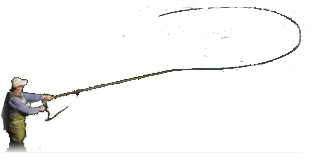-
Floatant and Tails
Hello, I have two questions. I am pretty much a tying beginner although I have fished for trout for many, many years. I have recently tied up a bunch of new flies and was wondering is it recommended to soak them in a floatant prior to using them? On the stream I usually use a paste, but thought that putting them in a bottle of floatant and then drying them would make them more buoyant and maybe more waterproof once I got to using them on the stream. Does anyone have any thoughts or recommendations on this?
Secondly, as far as Mayfly tails go, I notice that many tiers take a small bunch of hackle barbs and tie them in as tails. However, in reality, Mayflies have only 2 or 3 tail fibers. Should I only be looking to tie-in the number of tails fibers appropriate to the actual fly? If so I guess I would have to use the artificial Microfibetts in the proper color. and do they work as well? Any suggestions would be appreciated.
Thanks much for your advise.
-
Typically, I use Watershed to waterproof my flies at the tying desk, and I also use floatant on the stream.
There are no hard and fast rules to tails, but Microfibetts are mostly used for spinner patterns rather than as tails in general. A clump of hair or feathers is more common on most patterns, and fortunately trout cannot count. Good luck with your tying.
-
The 2-3 fiber tails do look more realistic, but even with spinners, I want the tail to help with floatation, so I still use a bunch of hackle barbs.
http://i80.photobucket.com/albums/j1...n/IMG_1105.jpg
Fish don't seem to care, even snooty tailwater ones.
For floatant, you could pre-game beforehand (Rain-x works great and is a lot cheaper than the same stuff marketed as fly floatant) and then grease it up on stream; too much like work for me though, I just gunk the fly before I use it. Dry Magic is my favorite; works well on cdc and everything else.
Regards,
Scott
-
Tails. As Scott points out it is a matter of mechanics. A dun standing on the meniscus (duns do not "float" as floating indicates displacement of water) usually holds its tail above the water. So if you are tying a pattern that will have its tails held above the water then yes imitate the number of tails. On most dun imitations the tail is used to support the fly. As it is supporting the bend of the hook it has more work to do than the hackle, which is at the "light" end of the hook. That's why we use a bunch of fibres for the tail. On spinners the tail is laid on the surface. So much more support is given by just a couple of split fibres.
Floatants. The ones used on the bench are usually different from the ones used on the water. It really is up to you which you use. A friend of mine uses one that you immerse the fly in. He treats all his dry flies after tying them. When he finishes fishing a fly he puts it onto a fly patch. Back at home at the end of the day he steams all the flies he used, re treats the dries and leaves them out over night to dry off. Next day he puts them back in his box. That seems a lot of trouble to go to to me. Also I often treat only part of the fly. Therefore I tend to use gel type floatant on the water.
Cheers,
A.
-
Craig Matthews says "trout can't count"
-
-
Best vise-side pretreat I've found/use is called Repel Well. Doesn't mess up CDC fibers. Your flies are easily rinsed in the stream/lake and false cast once or twice. Over and over, and over and over again and again. It seems to be a PERMANANT treatment.
-
Thanks to everyone for your comments. They are very helpful and I appreciate your time and will take your suggestions. Actually, it never even occurred to me that trout can't count as it seems they can do everything else to avoid my presentation so I just assumed.... Anyway, thanks again.
-
Who knows what a trout thinks a dry fky tail is? It could be an extension of the body or a trailing shuck as in a a sparkle dun.
-
I've found that splaying the tails helps with floating. Also avoids the issue of whether or not the typical bundled tail is seen by the trout as just more body.
Fly Tying and Fly Fishing Journal (a British mag - it's name is something like what I wrote) did a study a few years ago on floatant. Mag determined that the best combo was using Watershed at least 24 hours before fishing the fly and then using Shimazake Dry Shake during the day.
